title: “Unique Ornamental Native Grasses For Shape And Movement” ShowToc: true date: “2024-09-18” author: “George Edwards”
Choosing the Best Ornamental Native Grasses for Your Garden
Ornamental grasses can vary greatly from one species to the next. Size, form and overall growth habit will all help you determine which ornamental grass plant is a good fit for the garden. This is especially true of native types, which often demonstrate an improved tolerance to insect pressure and disease. When growing ornamental grasses, local species thrive where conditions for growth are ideal, and they support local wildlife and the backyard’s ecosystem.
1. Indian Grass
Like many taller species, these unique ornamental grasses add height and drama to a yard or garden bed. Indian grass (Sorghastrum nutans) sets its seed early. Over time, Indian grass plants will develop a notable warm, bronze hue. Though the grass may spread where conditions are ideal, growers seldom find it to be aggressive or invasive. Indian grass is further praised for its hardiness, adaptability and resistance to disease. Plants are hardy to USDA zones 3-9.
2. Big Bluestem
Known for its use within prairies and meadows, big bluestem (Andropogon gerardii) is a good choice for gardeners in search of tall, colorful foliage. As weather cools in autumn, big bluestem growers can expect beds filled with vibrant shades of copper, red, and orange. Plants should be trimmed routinely as a means to maintain a tidy, compact form. Big bluestem grass is hardy to USDA zones 3-9. Butterfly-friendly ‘Golden Sunset’ from Green Promise Farms adds a splash of rich tonal variety to native plantings. This vigorous grass combines blueish green grass blades with large golden seed heads.
3. Blue Fescue
Blue fescue (Festuca ovina glauca) grasses are among the most popular species used in the landscape. Plants are especially attractive when the weather is cool, often performing best in spring and early autumn. Its low, mounding habit makes blue fescue ideal for use as a groundcover or as bedding within mixed borders. Hardy fescue is known to thrive when planted in rock gardens and containers, as well. Plants are hardy to USDA zones 4-8.
4. Muhly Grass
A true show-stopper among ornamentals, gardeners are certain to delight in the color and appeal of muhly grass. As cooler weather approaches in fall, each of the plant’s plumes will take on an ethereal pink hue. Large plantings of muhly grass are especially attractive, as beds will seemingly glow with color. Muhly grass is generally considered easy to grow, as it native to much of the eastern United States. Plants are hardy to USDA zones 5-11.
5. Prairie Dropseed
Prairie dropseed (Sporobolus heterolepis) is most commonly planted amongst established perennials. Delicate foliage is used to add a light, airy appearance to beds. Plants add further interest to the growing space with their unique fragrance and fall color. As prairie dropseed plants play host to several species of butterflies and moths, their addition to the landscape can help to restore the garden ecosystem and improve its overall health. Plants are hardy to USDA zones 3-8.
6. Switchgrass
Another popular choice for meadows and naturalized spaces, switchgrass (Panicum virgatum) plays an important role in the creation of wildlife habitat. Established plantings of switchgrass serve as an invaluable source of food and shelter for birds and an array of small mammals. Plants are hardy to USDA zones 3-10.
7. Tufted Hairgrass
Known for its airy appearance, tufted hairgrass (Deschampsia cespitosa) can add elegance and sophistication to most any ornamental bed. Large plumes can be used as a focal flower or to draw the eye through the landscape. Plants are especially striking when arranged en masse or as an accent to pollinator gardens. Tufted hairgrass is hardy to USDA zones 4-8. This article features products available from third party vendors on the Gardening Know How Shop. Excellent for shade gardens and the cool season, this ornamental native from Green Promise Farms produces plumes of finely textured grass blades that shift from green to gold. Great in large containers.
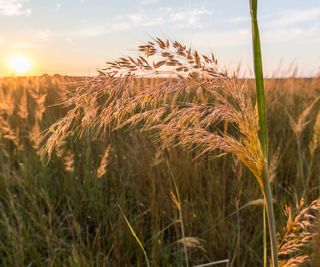
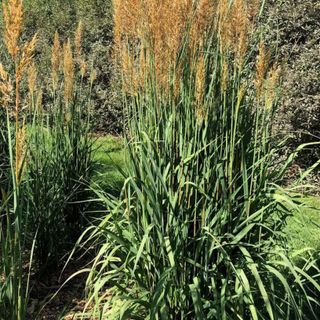
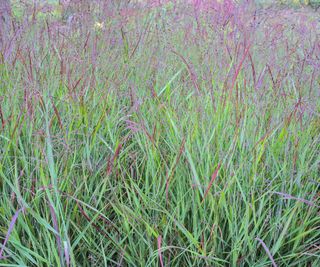
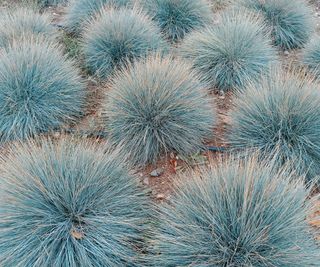
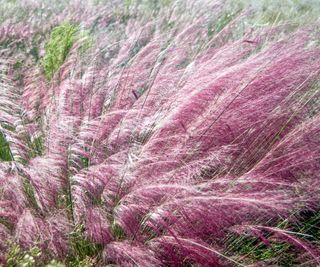
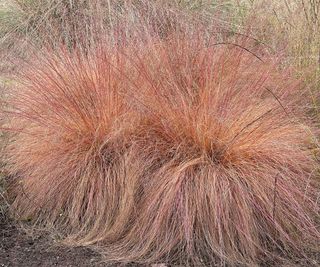
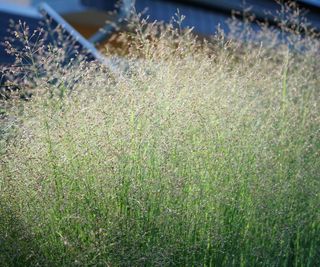
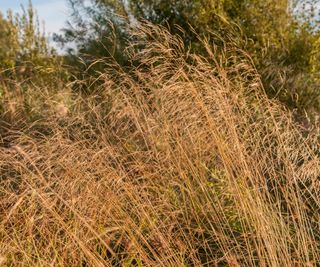
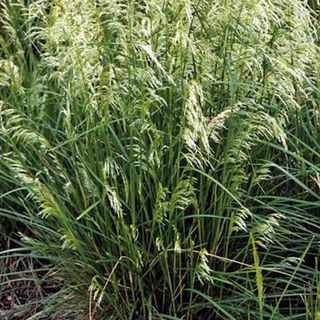
title: “Unique Ornamental Native Grasses For Shape And Movement” ShowToc: true date: “2024-08-29” author: “Taylor Boyd”
Choosing the Best Ornamental Native Grasses for Your Garden
Ornamental grasses can vary greatly from one species to the next. Size, form and overall growth habit will all help you determine which ornamental grass plant is a good fit for the garden. This is especially true of native types, which often demonstrate an improved tolerance to insect pressure and disease. When growing ornamental grasses, local species thrive where conditions for growth are ideal, and they support local wildlife and the backyard’s ecosystem.
1. Indian Grass
Like many taller species, these unique ornamental grasses add height and drama to a yard or garden bed. Indian grass (Sorghastrum nutans) sets its seed early. Over time, Indian grass plants will develop a notable warm, bronze hue. Though the grass may spread where conditions are ideal, growers seldom find it to be aggressive or invasive. Indian grass is further praised for its hardiness, adaptability and resistance to disease. Plants are hardy to USDA zones 3-9.
2. Big Bluestem
Known for its use within prairies and meadows, big bluestem (Andropogon gerardii) is a good choice for gardeners in search of tall, colorful foliage. As weather cools in autumn, big bluestem growers can expect beds filled with vibrant shades of copper, red, and orange. Plants should be trimmed routinely as a means to maintain a tidy, compact form. Big bluestem grass is hardy to USDA zones 3-9. Butterfly-friendly ‘Golden Sunset’ from Green Promise Farms adds a splash of rich tonal variety to native plantings. This vigorous grass combines blueish green grass blades with large golden seed heads.
3. Blue Fescue
Blue fescue (Festuca ovina glauca) grasses are among the most popular species used in the landscape. Plants are especially attractive when the weather is cool, often performing best in spring and early autumn. Its low, mounding habit makes blue fescue ideal for use as a groundcover or as bedding within mixed borders. Hardy fescue is known to thrive when planted in rock gardens and containers, as well. Plants are hardy to USDA zones 4-8.
4. Muhly Grass
A true show-stopper among ornamentals, gardeners are certain to delight in the color and appeal of muhly grass. As cooler weather approaches in fall, each of the plant’s plumes will take on an ethereal pink hue. Large plantings of muhly grass are especially attractive, as beds will seemingly glow with color. Muhly grass is generally considered easy to grow, as it native to much of the eastern United States. Plants are hardy to USDA zones 5-11.
5. Prairie Dropseed
Prairie dropseed (Sporobolus heterolepis) is most commonly planted amongst established perennials. Delicate foliage is used to add a light, airy appearance to beds. Plants add further interest to the growing space with their unique fragrance and fall color. As prairie dropseed plants play host to several species of butterflies and moths, their addition to the landscape can help to restore the garden ecosystem and improve its overall health. Plants are hardy to USDA zones 3-8.
6. Switchgrass
Another popular choice for meadows and naturalized spaces, switchgrass (Panicum virgatum) plays an important role in the creation of wildlife habitat. Established plantings of switchgrass serve as an invaluable source of food and shelter for birds and an array of small mammals. Plants are hardy to USDA zones 3-10.
7. Tufted Hairgrass
Known for its airy appearance, tufted hairgrass (Deschampsia cespitosa) can add elegance and sophistication to most any ornamental bed. Large plumes can be used as a focal flower or to draw the eye through the landscape. Plants are especially striking when arranged en masse or as an accent to pollinator gardens. Tufted hairgrass is hardy to USDA zones 4-8. This article features products available from third party vendors on the Gardening Know How Shop. Excellent for shade gardens and the cool season, this ornamental native from Green Promise Farms produces plumes of finely textured grass blades that shift from green to gold. Great in large containers.









title: “Unique Ornamental Native Grasses For Shape And Movement” ShowToc: true date: “2024-09-27” author: “Mary Nissen”
Choosing the Best Ornamental Native Grasses for Your Garden
Ornamental grasses can vary greatly from one species to the next. Size, form and overall growth habit will all help you determine which ornamental grass plant is a good fit for the garden. This is especially true of native types, which often demonstrate an improved tolerance to insect pressure and disease. When growing ornamental grasses, local species thrive where conditions for growth are ideal, and they support local wildlife and the backyard’s ecosystem.
1. Indian Grass
Like many taller species, these unique ornamental grasses add height and drama to a yard or garden bed. Indian grass (Sorghastrum nutans) sets its seed early. Over time, Indian grass plants will develop a notable warm, bronze hue. Though the grass may spread where conditions are ideal, growers seldom find it to be aggressive or invasive. Indian grass is further praised for its hardiness, adaptability and resistance to disease. Plants are hardy to USDA zones 3-9.
2. Big Bluestem
Known for its use within prairies and meadows, big bluestem (Andropogon gerardii) is a good choice for gardeners in search of tall, colorful foliage. As weather cools in autumn, big bluestem growers can expect beds filled with vibrant shades of copper, red, and orange. Plants should be trimmed routinely as a means to maintain a tidy, compact form. Big bluestem grass is hardy to USDA zones 3-9. Butterfly-friendly ‘Golden Sunset’ from Green Promise Farms adds a splash of rich tonal variety to native plantings. This vigorous grass combines blueish green grass blades with large golden seed heads.
3. Blue Fescue
Blue fescue (Festuca ovina glauca) grasses are among the most popular species used in the landscape. Plants are especially attractive when the weather is cool, often performing best in spring and early autumn. Its low, mounding habit makes blue fescue ideal for use as a groundcover or as bedding within mixed borders. Hardy fescue is known to thrive when planted in rock gardens and containers, as well. Plants are hardy to USDA zones 4-8.
4. Muhly Grass
A true show-stopper among ornamentals, gardeners are certain to delight in the color and appeal of muhly grass. As cooler weather approaches in fall, each of the plant’s plumes will take on an ethereal pink hue. Large plantings of muhly grass are especially attractive, as beds will seemingly glow with color. Muhly grass is generally considered easy to grow, as it native to much of the eastern United States. Plants are hardy to USDA zones 5-11.
5. Prairie Dropseed
Prairie dropseed (Sporobolus heterolepis) is most commonly planted amongst established perennials. Delicate foliage is used to add a light, airy appearance to beds. Plants add further interest to the growing space with their unique fragrance and fall color. As prairie dropseed plants play host to several species of butterflies and moths, their addition to the landscape can help to restore the garden ecosystem and improve its overall health. Plants are hardy to USDA zones 3-8.
6. Switchgrass
Another popular choice for meadows and naturalized spaces, switchgrass (Panicum virgatum) plays an important role in the creation of wildlife habitat. Established plantings of switchgrass serve as an invaluable source of food and shelter for birds and an array of small mammals. Plants are hardy to USDA zones 3-10.
7. Tufted Hairgrass
Known for its airy appearance, tufted hairgrass (Deschampsia cespitosa) can add elegance and sophistication to most any ornamental bed. Large plumes can be used as a focal flower or to draw the eye through the landscape. Plants are especially striking when arranged en masse or as an accent to pollinator gardens. Tufted hairgrass is hardy to USDA zones 4-8. This article features products available from third party vendors on the Gardening Know How Shop. Excellent for shade gardens and the cool season, this ornamental native from Green Promise Farms produces plumes of finely textured grass blades that shift from green to gold. Great in large containers.









title: “Unique Ornamental Native Grasses For Shape And Movement” ShowToc: true date: “2024-08-24” author: “Christina Snoke”
Choosing the Best Ornamental Native Grasses for Your Garden
Ornamental grasses can vary greatly from one species to the next. Size, form and overall growth habit will all help you determine which ornamental grass plant is a good fit for the garden. This is especially true of native types, which often demonstrate an improved tolerance to insect pressure and disease. When growing ornamental grasses, local species thrive where conditions for growth are ideal, and they support local wildlife and the backyard’s ecosystem.
1. Indian Grass
Like many taller species, these unique ornamental grasses add height and drama to a yard or garden bed. Indian grass (Sorghastrum nutans) sets its seed early. Over time, Indian grass plants will develop a notable warm, bronze hue. Though the grass may spread where conditions are ideal, growers seldom find it to be aggressive or invasive. Indian grass is further praised for its hardiness, adaptability and resistance to disease. Plants are hardy to USDA zones 3-9.
2. Big Bluestem
Known for its use within prairies and meadows, big bluestem (Andropogon gerardii) is a good choice for gardeners in search of tall, colorful foliage. As weather cools in autumn, big bluestem growers can expect beds filled with vibrant shades of copper, red, and orange. Plants should be trimmed routinely as a means to maintain a tidy, compact form. Big bluestem grass is hardy to USDA zones 3-9. Butterfly-friendly ‘Golden Sunset’ from Green Promise Farms adds a splash of rich tonal variety to native plantings. This vigorous grass combines blueish green grass blades with large golden seed heads.
3. Blue Fescue
Blue fescue (Festuca ovina glauca) grasses are among the most popular species used in the landscape. Plants are especially attractive when the weather is cool, often performing best in spring and early autumn. Its low, mounding habit makes blue fescue ideal for use as a groundcover or as bedding within mixed borders. Hardy fescue is known to thrive when planted in rock gardens and containers, as well. Plants are hardy to USDA zones 4-8.
4. Muhly Grass
A true show-stopper among ornamentals, gardeners are certain to delight in the color and appeal of muhly grass. As cooler weather approaches in fall, each of the plant’s plumes will take on an ethereal pink hue. Large plantings of muhly grass are especially attractive, as beds will seemingly glow with color. Muhly grass is generally considered easy to grow, as it native to much of the eastern United States. Plants are hardy to USDA zones 5-11.
5. Prairie Dropseed
Prairie dropseed (Sporobolus heterolepis) is most commonly planted amongst established perennials. Delicate foliage is used to add a light, airy appearance to beds. Plants add further interest to the growing space with their unique fragrance and fall color. As prairie dropseed plants play host to several species of butterflies and moths, their addition to the landscape can help to restore the garden ecosystem and improve its overall health. Plants are hardy to USDA zones 3-8.
6. Switchgrass
Another popular choice for meadows and naturalized spaces, switchgrass (Panicum virgatum) plays an important role in the creation of wildlife habitat. Established plantings of switchgrass serve as an invaluable source of food and shelter for birds and an array of small mammals. Plants are hardy to USDA zones 3-10.
7. Tufted Hairgrass
Known for its airy appearance, tufted hairgrass (Deschampsia cespitosa) can add elegance and sophistication to most any ornamental bed. Large plumes can be used as a focal flower or to draw the eye through the landscape. Plants are especially striking when arranged en masse or as an accent to pollinator gardens. Tufted hairgrass is hardy to USDA zones 4-8. This article features products available from third party vendors on the Gardening Know How Shop. Excellent for shade gardens and the cool season, this ornamental native from Green Promise Farms produces plumes of finely textured grass blades that shift from green to gold. Great in large containers.









title: “Unique Ornamental Native Grasses For Shape And Movement” ShowToc: true date: “2024-09-19” author: “Donna Luvene”
Choosing the Best Ornamental Native Grasses for Your Garden
Ornamental grasses can vary greatly from one species to the next. Size, form and overall growth habit will all help you determine which ornamental grass plant is a good fit for the garden. This is especially true of native types, which often demonstrate an improved tolerance to insect pressure and disease. When growing ornamental grasses, local species thrive where conditions for growth are ideal, and they support local wildlife and the backyard’s ecosystem.
1. Indian Grass
Like many taller species, these unique ornamental grasses add height and drama to a yard or garden bed. Indian grass (Sorghastrum nutans) sets its seed early. Over time, Indian grass plants will develop a notable warm, bronze hue. Though the grass may spread where conditions are ideal, growers seldom find it to be aggressive or invasive. Indian grass is further praised for its hardiness, adaptability and resistance to disease. Plants are hardy to USDA zones 3-9.
2. Big Bluestem
Known for its use within prairies and meadows, big bluestem (Andropogon gerardii) is a good choice for gardeners in search of tall, colorful foliage. As weather cools in autumn, big bluestem growers can expect beds filled with vibrant shades of copper, red, and orange. Plants should be trimmed routinely as a means to maintain a tidy, compact form. Big bluestem grass is hardy to USDA zones 3-9. Butterfly-friendly ‘Golden Sunset’ from Green Promise Farms adds a splash of rich tonal variety to native plantings. This vigorous grass combines blueish green grass blades with large golden seed heads.
3. Blue Fescue
Blue fescue (Festuca ovina glauca) grasses are among the most popular species used in the landscape. Plants are especially attractive when the weather is cool, often performing best in spring and early autumn. Its low, mounding habit makes blue fescue ideal for use as a groundcover or as bedding within mixed borders. Hardy fescue is known to thrive when planted in rock gardens and containers, as well. Plants are hardy to USDA zones 4-8.
4. Muhly Grass
A true show-stopper among ornamentals, gardeners are certain to delight in the color and appeal of muhly grass. As cooler weather approaches in fall, each of the plant’s plumes will take on an ethereal pink hue. Large plantings of muhly grass are especially attractive, as beds will seemingly glow with color. Muhly grass is generally considered easy to grow, as it native to much of the eastern United States. Plants are hardy to USDA zones 5-11.
5. Prairie Dropseed
Prairie dropseed (Sporobolus heterolepis) is most commonly planted amongst established perennials. Delicate foliage is used to add a light, airy appearance to beds. Plants add further interest to the growing space with their unique fragrance and fall color. As prairie dropseed plants play host to several species of butterflies and moths, their addition to the landscape can help to restore the garden ecosystem and improve its overall health. Plants are hardy to USDA zones 3-8.
6. Switchgrass
Another popular choice for meadows and naturalized spaces, switchgrass (Panicum virgatum) plays an important role in the creation of wildlife habitat. Established plantings of switchgrass serve as an invaluable source of food and shelter for birds and an array of small mammals. Plants are hardy to USDA zones 3-10.
7. Tufted Hairgrass
Known for its airy appearance, tufted hairgrass (Deschampsia cespitosa) can add elegance and sophistication to most any ornamental bed. Large plumes can be used as a focal flower or to draw the eye through the landscape. Plants are especially striking when arranged en masse or as an accent to pollinator gardens. Tufted hairgrass is hardy to USDA zones 4-8. This article features products available from third party vendors on the Gardening Know How Shop. Excellent for shade gardens and the cool season, this ornamental native from Green Promise Farms produces plumes of finely textured grass blades that shift from green to gold. Great in large containers.









title: “Unique Ornamental Native Grasses For Shape And Movement” ShowToc: true date: “2024-09-01” author: “Susan Angel”
Choosing the Best Ornamental Native Grasses for Your Garden
Ornamental grasses can vary greatly from one species to the next. Size, form and overall growth habit will all help you determine which ornamental grass plant is a good fit for the garden. This is especially true of native types, which often demonstrate an improved tolerance to insect pressure and disease. When growing ornamental grasses, local species thrive where conditions for growth are ideal, and they support local wildlife and the backyard’s ecosystem.
1. Indian Grass
Like many taller species, these unique ornamental grasses add height and drama to a yard or garden bed. Indian grass (Sorghastrum nutans) sets its seed early. Over time, Indian grass plants will develop a notable warm, bronze hue. Though the grass may spread where conditions are ideal, growers seldom find it to be aggressive or invasive. Indian grass is further praised for its hardiness, adaptability and resistance to disease. Plants are hardy to USDA zones 3-9.
2. Big Bluestem
Known for its use within prairies and meadows, big bluestem (Andropogon gerardii) is a good choice for gardeners in search of tall, colorful foliage. As weather cools in autumn, big bluestem growers can expect beds filled with vibrant shades of copper, red, and orange. Plants should be trimmed routinely as a means to maintain a tidy, compact form. Big bluestem grass is hardy to USDA zones 3-9. Butterfly-friendly ‘Golden Sunset’ from Green Promise Farms adds a splash of rich tonal variety to native plantings. This vigorous grass combines blueish green grass blades with large golden seed heads.
3. Blue Fescue
Blue fescue (Festuca ovina glauca) grasses are among the most popular species used in the landscape. Plants are especially attractive when the weather is cool, often performing best in spring and early autumn. Its low, mounding habit makes blue fescue ideal for use as a groundcover or as bedding within mixed borders. Hardy fescue is known to thrive when planted in rock gardens and containers, as well. Plants are hardy to USDA zones 4-8.
4. Muhly Grass
A true show-stopper among ornamentals, gardeners are certain to delight in the color and appeal of muhly grass. As cooler weather approaches in fall, each of the plant’s plumes will take on an ethereal pink hue. Large plantings of muhly grass are especially attractive, as beds will seemingly glow with color. Muhly grass is generally considered easy to grow, as it native to much of the eastern United States. Plants are hardy to USDA zones 5-11.
5. Prairie Dropseed
Prairie dropseed (Sporobolus heterolepis) is most commonly planted amongst established perennials. Delicate foliage is used to add a light, airy appearance to beds. Plants add further interest to the growing space with their unique fragrance and fall color. As prairie dropseed plants play host to several species of butterflies and moths, their addition to the landscape can help to restore the garden ecosystem and improve its overall health. Plants are hardy to USDA zones 3-8.
6. Switchgrass
Another popular choice for meadows and naturalized spaces, switchgrass (Panicum virgatum) plays an important role in the creation of wildlife habitat. Established plantings of switchgrass serve as an invaluable source of food and shelter for birds and an array of small mammals. Plants are hardy to USDA zones 3-10.
7. Tufted Hairgrass
Known for its airy appearance, tufted hairgrass (Deschampsia cespitosa) can add elegance and sophistication to most any ornamental bed. Large plumes can be used as a focal flower or to draw the eye through the landscape. Plants are especially striking when arranged en masse or as an accent to pollinator gardens. Tufted hairgrass is hardy to USDA zones 4-8. This article features products available from third party vendors on the Gardening Know How Shop. Excellent for shade gardens and the cool season, this ornamental native from Green Promise Farms produces plumes of finely textured grass blades that shift from green to gold. Great in large containers.









title: “Unique Ornamental Native Grasses For Shape And Movement” ShowToc: true date: “2024-09-10” author: “Corey Cloe”
Choosing the Best Ornamental Native Grasses for Your Garden
Ornamental grasses can vary greatly from one species to the next. Size, form and overall growth habit will all help you determine which ornamental grass plant is a good fit for the garden. This is especially true of native types, which often demonstrate an improved tolerance to insect pressure and disease. When growing ornamental grasses, local species thrive where conditions for growth are ideal, and they support local wildlife and the backyard’s ecosystem.
1. Indian Grass
Like many taller species, these unique ornamental grasses add height and drama to a yard or garden bed. Indian grass (Sorghastrum nutans) sets its seed early. Over time, Indian grass plants will develop a notable warm, bronze hue. Though the grass may spread where conditions are ideal, growers seldom find it to be aggressive or invasive. Indian grass is further praised for its hardiness, adaptability and resistance to disease. Plants are hardy to USDA zones 3-9.
2. Big Bluestem
Known for its use within prairies and meadows, big bluestem (Andropogon gerardii) is a good choice for gardeners in search of tall, colorful foliage. As weather cools in autumn, big bluestem growers can expect beds filled with vibrant shades of copper, red, and orange. Plants should be trimmed routinely as a means to maintain a tidy, compact form. Big bluestem grass is hardy to USDA zones 3-9. Butterfly-friendly ‘Golden Sunset’ from Green Promise Farms adds a splash of rich tonal variety to native plantings. This vigorous grass combines blueish green grass blades with large golden seed heads.
3. Blue Fescue
Blue fescue (Festuca ovina glauca) grasses are among the most popular species used in the landscape. Plants are especially attractive when the weather is cool, often performing best in spring and early autumn. Its low, mounding habit makes blue fescue ideal for use as a groundcover or as bedding within mixed borders. Hardy fescue is known to thrive when planted in rock gardens and containers, as well. Plants are hardy to USDA zones 4-8.
4. Muhly Grass
A true show-stopper among ornamentals, gardeners are certain to delight in the color and appeal of muhly grass. As cooler weather approaches in fall, each of the plant’s plumes will take on an ethereal pink hue. Large plantings of muhly grass are especially attractive, as beds will seemingly glow with color. Muhly grass is generally considered easy to grow, as it native to much of the eastern United States. Plants are hardy to USDA zones 5-11.
5. Prairie Dropseed
Prairie dropseed (Sporobolus heterolepis) is most commonly planted amongst established perennials. Delicate foliage is used to add a light, airy appearance to beds. Plants add further interest to the growing space with their unique fragrance and fall color. As prairie dropseed plants play host to several species of butterflies and moths, their addition to the landscape can help to restore the garden ecosystem and improve its overall health. Plants are hardy to USDA zones 3-8.
6. Switchgrass
Another popular choice for meadows and naturalized spaces, switchgrass (Panicum virgatum) plays an important role in the creation of wildlife habitat. Established plantings of switchgrass serve as an invaluable source of food and shelter for birds and an array of small mammals. Plants are hardy to USDA zones 3-10.
7. Tufted Hairgrass
Known for its airy appearance, tufted hairgrass (Deschampsia cespitosa) can add elegance and sophistication to most any ornamental bed. Large plumes can be used as a focal flower or to draw the eye through the landscape. Plants are especially striking when arranged en masse or as an accent to pollinator gardens. Tufted hairgrass is hardy to USDA zones 4-8. This article features products available from third party vendors on the Gardening Know How Shop. Excellent for shade gardens and the cool season, this ornamental native from Green Promise Farms produces plumes of finely textured grass blades that shift from green to gold. Great in large containers.









title: “Unique Ornamental Native Grasses For Shape And Movement” ShowToc: true date: “2024-09-27” author: “Emerson Bernhardt”
Choosing the Best Ornamental Native Grasses for Your Garden
Ornamental grasses can vary greatly from one species to the next. Size, form and overall growth habit will all help you determine which ornamental grass plant is a good fit for the garden. This is especially true of native types, which often demonstrate an improved tolerance to insect pressure and disease. When growing ornamental grasses, local species thrive where conditions for growth are ideal, and they support local wildlife and the backyard’s ecosystem.
1. Indian Grass
Like many taller species, these unique ornamental grasses add height and drama to a yard or garden bed. Indian grass (Sorghastrum nutans) sets its seed early. Over time, Indian grass plants will develop a notable warm, bronze hue. Though the grass may spread where conditions are ideal, growers seldom find it to be aggressive or invasive. Indian grass is further praised for its hardiness, adaptability and resistance to disease. Plants are hardy to USDA zones 3-9.
2. Big Bluestem
Known for its use within prairies and meadows, big bluestem (Andropogon gerardii) is a good choice for gardeners in search of tall, colorful foliage. As weather cools in autumn, big bluestem growers can expect beds filled with vibrant shades of copper, red, and orange. Plants should be trimmed routinely as a means to maintain a tidy, compact form. Big bluestem grass is hardy to USDA zones 3-9. Butterfly-friendly ‘Golden Sunset’ from Green Promise Farms adds a splash of rich tonal variety to native plantings. This vigorous grass combines blueish green grass blades with large golden seed heads.
3. Blue Fescue
Blue fescue (Festuca ovina glauca) grasses are among the most popular species used in the landscape. Plants are especially attractive when the weather is cool, often performing best in spring and early autumn. Its low, mounding habit makes blue fescue ideal for use as a groundcover or as bedding within mixed borders. Hardy fescue is known to thrive when planted in rock gardens and containers, as well. Plants are hardy to USDA zones 4-8.
4. Muhly Grass
A true show-stopper among ornamentals, gardeners are certain to delight in the color and appeal of muhly grass. As cooler weather approaches in fall, each of the plant’s plumes will take on an ethereal pink hue. Large plantings of muhly grass are especially attractive, as beds will seemingly glow with color. Muhly grass is generally considered easy to grow, as it native to much of the eastern United States. Plants are hardy to USDA zones 5-11.
5. Prairie Dropseed
Prairie dropseed (Sporobolus heterolepis) is most commonly planted amongst established perennials. Delicate foliage is used to add a light, airy appearance to beds. Plants add further interest to the growing space with their unique fragrance and fall color. As prairie dropseed plants play host to several species of butterflies and moths, their addition to the landscape can help to restore the garden ecosystem and improve its overall health. Plants are hardy to USDA zones 3-8.
6. Switchgrass
Another popular choice for meadows and naturalized spaces, switchgrass (Panicum virgatum) plays an important role in the creation of wildlife habitat. Established plantings of switchgrass serve as an invaluable source of food and shelter for birds and an array of small mammals. Plants are hardy to USDA zones 3-10.
7. Tufted Hairgrass
Known for its airy appearance, tufted hairgrass (Deschampsia cespitosa) can add elegance and sophistication to most any ornamental bed. Large plumes can be used as a focal flower or to draw the eye through the landscape. Plants are especially striking when arranged en masse or as an accent to pollinator gardens. Tufted hairgrass is hardy to USDA zones 4-8. This article features products available from third party vendors on the Gardening Know How Shop. Excellent for shade gardens and the cool season, this ornamental native from Green Promise Farms produces plumes of finely textured grass blades that shift from green to gold. Great in large containers.









title: “Unique Ornamental Native Grasses For Shape And Movement” ShowToc: true date: “2024-09-06” author: “Kenneth Burke”
Choosing the Best Ornamental Native Grasses for Your Garden
Ornamental grasses can vary greatly from one species to the next. Size, form and overall growth habit will all help you determine which ornamental grass plant is a good fit for the garden. This is especially true of native types, which often demonstrate an improved tolerance to insect pressure and disease. When growing ornamental grasses, local species thrive where conditions for growth are ideal, and they support local wildlife and the backyard’s ecosystem.
1. Indian Grass
Like many taller species, these unique ornamental grasses add height and drama to a yard or garden bed. Indian grass (Sorghastrum nutans) sets its seed early. Over time, Indian grass plants will develop a notable warm, bronze hue. Though the grass may spread where conditions are ideal, growers seldom find it to be aggressive or invasive. Indian grass is further praised for its hardiness, adaptability and resistance to disease. Plants are hardy to USDA zones 3-9.
2. Big Bluestem
Known for its use within prairies and meadows, big bluestem (Andropogon gerardii) is a good choice for gardeners in search of tall, colorful foliage. As weather cools in autumn, big bluestem growers can expect beds filled with vibrant shades of copper, red, and orange. Plants should be trimmed routinely as a means to maintain a tidy, compact form. Big bluestem grass is hardy to USDA zones 3-9. Butterfly-friendly ‘Golden Sunset’ from Green Promise Farms adds a splash of rich tonal variety to native plantings. This vigorous grass combines blueish green grass blades with large golden seed heads.
3. Blue Fescue
Blue fescue (Festuca ovina glauca) grasses are among the most popular species used in the landscape. Plants are especially attractive when the weather is cool, often performing best in spring and early autumn. Its low, mounding habit makes blue fescue ideal for use as a groundcover or as bedding within mixed borders. Hardy fescue is known to thrive when planted in rock gardens and containers, as well. Plants are hardy to USDA zones 4-8.
4. Muhly Grass
A true show-stopper among ornamentals, gardeners are certain to delight in the color and appeal of muhly grass. As cooler weather approaches in fall, each of the plant’s plumes will take on an ethereal pink hue. Large plantings of muhly grass are especially attractive, as beds will seemingly glow with color. Muhly grass is generally considered easy to grow, as it native to much of the eastern United States. Plants are hardy to USDA zones 5-11.
5. Prairie Dropseed
Prairie dropseed (Sporobolus heterolepis) is most commonly planted amongst established perennials. Delicate foliage is used to add a light, airy appearance to beds. Plants add further interest to the growing space with their unique fragrance and fall color. As prairie dropseed plants play host to several species of butterflies and moths, their addition to the landscape can help to restore the garden ecosystem and improve its overall health. Plants are hardy to USDA zones 3-8.
6. Switchgrass
Another popular choice for meadows and naturalized spaces, switchgrass (Panicum virgatum) plays an important role in the creation of wildlife habitat. Established plantings of switchgrass serve as an invaluable source of food and shelter for birds and an array of small mammals. Plants are hardy to USDA zones 3-10.
7. Tufted Hairgrass
Known for its airy appearance, tufted hairgrass (Deschampsia cespitosa) can add elegance and sophistication to most any ornamental bed. Large plumes can be used as a focal flower or to draw the eye through the landscape. Plants are especially striking when arranged en masse or as an accent to pollinator gardens. Tufted hairgrass is hardy to USDA zones 4-8. This article features products available from third party vendors on the Gardening Know How Shop. Excellent for shade gardens and the cool season, this ornamental native from Green Promise Farms produces plumes of finely textured grass blades that shift from green to gold. Great in large containers.









title: “Unique Ornamental Native Grasses For Shape And Movement” ShowToc: true date: “2024-10-06” author: “Carolyn Boyne”
Choosing the Best Ornamental Native Grasses for Your Garden
Ornamental grasses can vary greatly from one species to the next. Size, form and overall growth habit will all help you determine which ornamental grass plant is a good fit for the garden. This is especially true of native types, which often demonstrate an improved tolerance to insect pressure and disease. When growing ornamental grasses, local species thrive where conditions for growth are ideal, and they support local wildlife and the backyard’s ecosystem.
1. Indian Grass
Like many taller species, these unique ornamental grasses add height and drama to a yard or garden bed. Indian grass (Sorghastrum nutans) sets its seed early. Over time, Indian grass plants will develop a notable warm, bronze hue. Though the grass may spread where conditions are ideal, growers seldom find it to be aggressive or invasive. Indian grass is further praised for its hardiness, adaptability and resistance to disease. Plants are hardy to USDA zones 3-9.
2. Big Bluestem
Known for its use within prairies and meadows, big bluestem (Andropogon gerardii) is a good choice for gardeners in search of tall, colorful foliage. As weather cools in autumn, big bluestem growers can expect beds filled with vibrant shades of copper, red, and orange. Plants should be trimmed routinely as a means to maintain a tidy, compact form. Big bluestem grass is hardy to USDA zones 3-9. Butterfly-friendly ‘Golden Sunset’ from Green Promise Farms adds a splash of rich tonal variety to native plantings. This vigorous grass combines blueish green grass blades with large golden seed heads.
3. Blue Fescue
Blue fescue (Festuca ovina glauca) grasses are among the most popular species used in the landscape. Plants are especially attractive when the weather is cool, often performing best in spring and early autumn. Its low, mounding habit makes blue fescue ideal for use as a groundcover or as bedding within mixed borders. Hardy fescue is known to thrive when planted in rock gardens and containers, as well. Plants are hardy to USDA zones 4-8.
4. Muhly Grass
A true show-stopper among ornamentals, gardeners are certain to delight in the color and appeal of muhly grass. As cooler weather approaches in fall, each of the plant’s plumes will take on an ethereal pink hue. Large plantings of muhly grass are especially attractive, as beds will seemingly glow with color. Muhly grass is generally considered easy to grow, as it native to much of the eastern United States. Plants are hardy to USDA zones 5-11.
5. Prairie Dropseed
Prairie dropseed (Sporobolus heterolepis) is most commonly planted amongst established perennials. Delicate foliage is used to add a light, airy appearance to beds. Plants add further interest to the growing space with their unique fragrance and fall color. As prairie dropseed plants play host to several species of butterflies and moths, their addition to the landscape can help to restore the garden ecosystem and improve its overall health. Plants are hardy to USDA zones 3-8.
6. Switchgrass
Another popular choice for meadows and naturalized spaces, switchgrass (Panicum virgatum) plays an important role in the creation of wildlife habitat. Established plantings of switchgrass serve as an invaluable source of food and shelter for birds and an array of small mammals. Plants are hardy to USDA zones 3-10.
7. Tufted Hairgrass
Known for its airy appearance, tufted hairgrass (Deschampsia cespitosa) can add elegance and sophistication to most any ornamental bed. Large plumes can be used as a focal flower or to draw the eye through the landscape. Plants are especially striking when arranged en masse or as an accent to pollinator gardens. Tufted hairgrass is hardy to USDA zones 4-8. This article features products available from third party vendors on the Gardening Know How Shop. Excellent for shade gardens and the cool season, this ornamental native from Green Promise Farms produces plumes of finely textured grass blades that shift from green to gold. Great in large containers.









title: “Unique Ornamental Native Grasses For Shape And Movement” ShowToc: true date: “2024-08-28” author: “John Sanders”
Choosing the Best Ornamental Native Grasses for Your Garden
Ornamental grasses can vary greatly from one species to the next. Size, form and overall growth habit will all help you determine which ornamental grass plant is a good fit for the garden. This is especially true of native types, which often demonstrate an improved tolerance to insect pressure and disease. When growing ornamental grasses, local species thrive where conditions for growth are ideal, and they support local wildlife and the backyard’s ecosystem.
1. Indian Grass
Like many taller species, these unique ornamental grasses add height and drama to a yard or garden bed. Indian grass (Sorghastrum nutans) sets its seed early. Over time, Indian grass plants will develop a notable warm, bronze hue. Though the grass may spread where conditions are ideal, growers seldom find it to be aggressive or invasive. Indian grass is further praised for its hardiness, adaptability and resistance to disease. Plants are hardy to USDA zones 3-9.
2. Big Bluestem
Known for its use within prairies and meadows, big bluestem (Andropogon gerardii) is a good choice for gardeners in search of tall, colorful foliage. As weather cools in autumn, big bluestem growers can expect beds filled with vibrant shades of copper, red, and orange. Plants should be trimmed routinely as a means to maintain a tidy, compact form. Big bluestem grass is hardy to USDA zones 3-9. Butterfly-friendly ‘Golden Sunset’ from Green Promise Farms adds a splash of rich tonal variety to native plantings. This vigorous grass combines blueish green grass blades with large golden seed heads.
3. Blue Fescue
Blue fescue (Festuca ovina glauca) grasses are among the most popular species used in the landscape. Plants are especially attractive when the weather is cool, often performing best in spring and early autumn. Its low, mounding habit makes blue fescue ideal for use as a groundcover or as bedding within mixed borders. Hardy fescue is known to thrive when planted in rock gardens and containers, as well. Plants are hardy to USDA zones 4-8.
4. Muhly Grass
A true show-stopper among ornamentals, gardeners are certain to delight in the color and appeal of muhly grass. As cooler weather approaches in fall, each of the plant’s plumes will take on an ethereal pink hue. Large plantings of muhly grass are especially attractive, as beds will seemingly glow with color. Muhly grass is generally considered easy to grow, as it native to much of the eastern United States. Plants are hardy to USDA zones 5-11.
5. Prairie Dropseed
Prairie dropseed (Sporobolus heterolepis) is most commonly planted amongst established perennials. Delicate foliage is used to add a light, airy appearance to beds. Plants add further interest to the growing space with their unique fragrance and fall color. As prairie dropseed plants play host to several species of butterflies and moths, their addition to the landscape can help to restore the garden ecosystem and improve its overall health. Plants are hardy to USDA zones 3-8.
6. Switchgrass
Another popular choice for meadows and naturalized spaces, switchgrass (Panicum virgatum) plays an important role in the creation of wildlife habitat. Established plantings of switchgrass serve as an invaluable source of food and shelter for birds and an array of small mammals. Plants are hardy to USDA zones 3-10.
7. Tufted Hairgrass
Known for its airy appearance, tufted hairgrass (Deschampsia cespitosa) can add elegance and sophistication to most any ornamental bed. Large plumes can be used as a focal flower or to draw the eye through the landscape. Plants are especially striking when arranged en masse or as an accent to pollinator gardens. Tufted hairgrass is hardy to USDA zones 4-8. This article features products available from third party vendors on the Gardening Know How Shop. Excellent for shade gardens and the cool season, this ornamental native from Green Promise Farms produces plumes of finely textured grass blades that shift from green to gold. Great in large containers.








